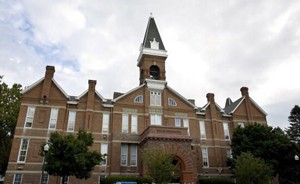Old Main, Drake University
Introduction
Text-to-speech Audio
Constructed between 1881 and 1883, Old Main was the first building on the Drake University campus. The building housed all of the university's offices and classrooms in the early years of the college, and its chapel served both religious functions and university events. Sheeslow Auditorium was added in 1900 and extensive renovations expanded the structure three years later. Considered one of the leading universities in the Midwest, Drake University was established in 1881 by George T. Carpenter and Francis Marion Drake. Drake was a Civil War general and served as Iowa governor from 1896 to 1898. Carpenter was a teacher, pastor, and the university's first president and chancellor. The university, which is named after Drake, was originally affiliated with the Christian Church (Disciples of Christ) Protestant denomination. Old Main and five additional buildings comprise the Drake University Campus Historic District, which is listed on the National Register of Historic Places. The campus plan and nine modern buildings were designed by world-renowned father and son architects Eliel and Eero Saarinen.
Images
Drake University was established in 1881. This building, Old Main, was erected in 1883 and is one of the oldest on campus.

Backstory and Context
Text-to-speech Audio
The Christian Church (Disciples of Christ) established Oskaloosa College in 1858 in the town of Oskaloosa, which is 58 miles away. Church members in Des Moines proposed that the college be relocated to Des Moines but the college and its financial backers rejected the idea. However, the appeal of establishing a university in Des Moines rose as the capital city grew prospered. As a result, Carpenter and Drake, who was a member of the Christian Church, established Drake University in 1881. Oskaloosa College eventually closed in 1900 due to lack of financial support as most of the state's affluent backers (many of whom were church members as well) donated funds to Drake University.
The university grew quickly, and by 1900, there were around 1,600 students pursuing degrees in the liberal arts, medicine, law, and commerce. The first of the buildings in the historic district, Old Main, was built in 1883. The others—Howard Hall, Cole Hall, Memorial Hall, the Carnegie Library, and the Christian Church—were built in the early 1900s. The library is named after philanthropist Andrew Carnegie, who donated funds to build it in 1907. The library represents the end of the university's affiliation with the Christian Church. In order to receive funds from Carnegie, organizations had to be non-sectarian.
The university hired Eiliel and Eero Saarinen, apparently in the late 1940s, to design the campus plan and buildings to house the science departments and pharmacy school. Eiliel died in 1950 but Eero designed several buildings including the Hubbell Dining Hall and the Quad Residence Halls. The buildings were built with brick, glass and metal and resembled factories. This was on purpose as it symbolized the university's aim to be modern, innovative and forward-looking.
Sources
Long, Barbara Beving. "Drake University Campus Historic District." National Park Service - National Register of Historic Places Nomination Form. September 8, 1988. https://npgallery.nps.gov/GetAsset/68e5f699-d270-4335-bb07-48dd851c8085.
Long, Barbara Beving. "Drake University and Related Properties in Des Moines, Iowa, 1881-1918." https://s3.amazonaws.com/NARAprodstorage/lz/electronic-records/rg-079/NPS_IA/64500153.pdf.
"Saarinen exhibit explores the building of a modern campus at Drake." Drake University. Accessed February 4, 2022. https://news.drake.edu/2008/11/03/saarinen-exhibit-explores-the-building-of-a-modern-campus-at-drake.
Wikimedia Commons: https://commons.wikimedia.org/wiki/File:Oldmaindrake.jpg
